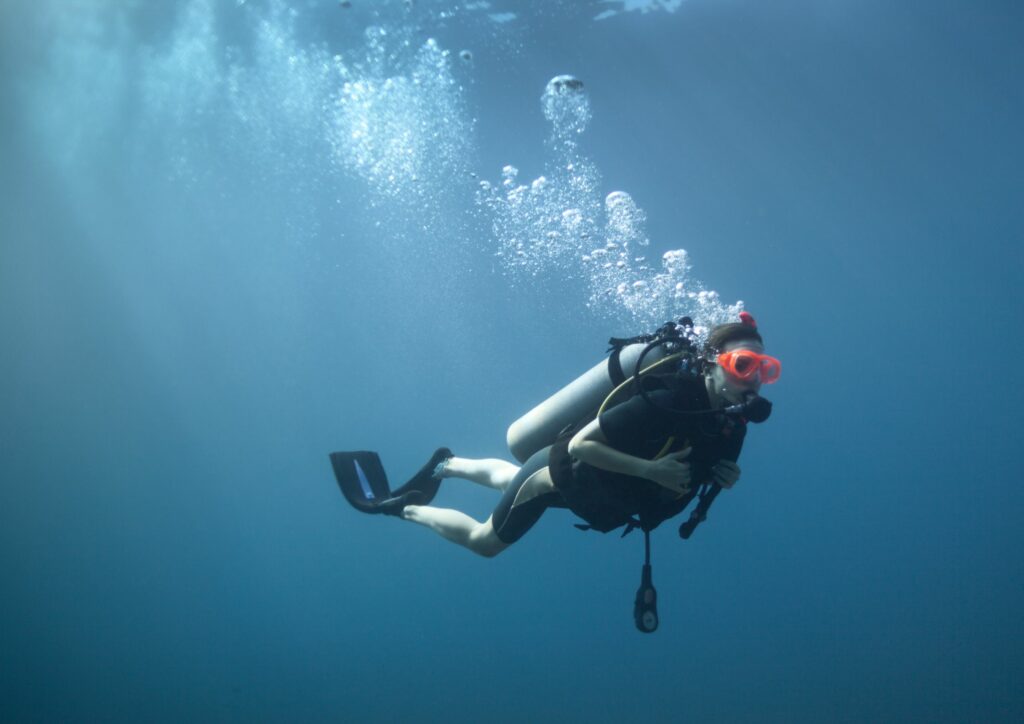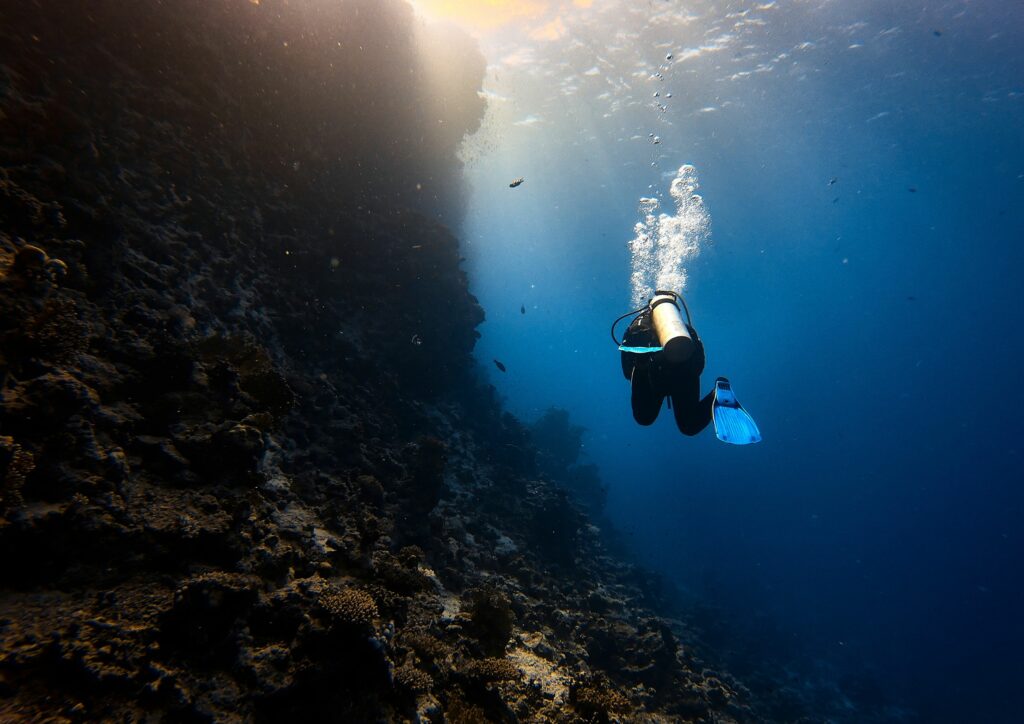Submerge into the mystic world beneath the ocean’s surface. It’s a realm where both beauty and danger intertwine—filled with magnificent species and rich phenomena waiting to be explored. But in order to navigate this underwater universe with finesse, mastering the principal scuba diving fin kicks is crucial. Let’s embark on a journey to understand the nuances of Flutter Kick, Frog Kick, Modified Flutter Kick, and Back Kick that can enhance your scuba diving adventures!
Float Like A Butterfly: The Fin Kicks – Flutter Kick
Dubbed as the most commonly known and straightforward among the four fin kicks, the Flutter Kick is akin to the natural style employed in swimming. This method commences with a steady push from the hip, utilizing straight legs, alternating each subsequently to garner forward momentum. Overlaying its practicality across an array of conditions, it shines especially in open water bodies and straightforward swim paths. This technique facilitates a steady pace, perfect for maintaining consistent strides in your swim. However, a note of caution for all those employing this kick: while it allows swift propulsion, care must be taken not to disturb the seabed or coral reefs, hence maintaining harmony with the marine ecosystem and its fragile life forms.
Leap Like A Frog: The Frog Kick
True to its namesake, the Frog Kick mirrors the movability pattern of a frog’s hind legs whilst swimming. This technique implements a horizontal rather than a vertical motion. The legs are diverged sideways, flexed at the knees, and subsequently pushed backwards in a simultaneous manner. The Frog Kick is a powerhouse of efficiency, stirring up minimal sediment, making it favorable for navigating through cramped spaces or sensitive environments. The exceptional design of this fin kicks technique also minimizes the likelihood of straining your muscles, turning it into a preferred choice amongst diving fanatics. It’s a leap forward in underwater maneuverability.
Modified Flutter Kick: A Harmonious Blend
A magnificent blend of both the Flutter and Frog Kick techniques, the Modified Flutter Kick brings the best of both realms. This amalgamation incorporates a slight flex of the knee originating from the frog kick technique paired with the vertical motion characteristic of the flutter kick. This unique modification significantly reduces strain on the lower back muscles making it the go-to choice for extended dives. It remarkably merges speed with control, enabling divers not just to explore, but truly experience the intricacy and splendor of underwater terrains.
The Finishing Touch: Back Kick
The Back Kick is deployed when divers are required to evade an obstacle or transition in reverse. This demanding technique employs a movement contrary to the direction of the swim, with your fins guiding the shift in course. With adequate practice and mastering this technique, divers can adaptably explore tight spaces and swim through complex underwater caves or reverse without the need to turn around—a vital skill when observing marine life or to prevent inadvertent contact with delicate marine ecosystems. Back Kick, indeed, lends the finishing touch to a diver’s repertoire.
Dive Deeper, Kick Better

Mastering the four basic scuba diving fin kicks is essential for any diver looking to enhance their Bali diving experience. The flutter kick, frog kick, helicopter turn, and back kick each offer unique advantages that can help divers navigate Bali’s diverse underwater landscapes more efficiently. The flutter kick, ideal for covering long distances, is perfect for exploring the expansive coral reefs of Menjangan Island.
The frog kick provides better control and is less disruptive to the marine environment, making it excellent for the delicate coral gardens of Amed. The helicopter turn allows for precise maneuvering in tight spaces, useful when navigating the intricate wrecks around Tulamben. Finally, the back kick helps maintain position without stirring up sediment, crucial for observing Bali’s abundant marine life in clear visibility. By mastering these fin kicks, divers can dive deeper, kick better, and fully immerse themselves in the unparalleled beauty of Bali diving.

As someone who’s been scuba diving for years, I appreciate how this article highlights the importance of mastering different fin kicks. It’s amazing how much more you can experience and appreciate when you take the time to learn proper techniques
Thank you for sharing your experience, May Wong! We’re thrilled to hear that our article has resonated with a seasoned scuba diver like yourself. Mastering different fin kicks can indeed elevate the entire diving experience, allowing you to explore more effectively and safely. At Gill Divers, we strive to provide our divers with the knowledge and skills needed to fully appreciate the ocean’s wonders. If you have any questions or would like to learn more about our scuba diving courses, please don’t hesitate to contact us at Tel: +65 6734 9373 or Email: [email protected]. We’re always here to help.
I’m loving this article! As a scuba diving enthusiast, I can attest that mastering fin kicks is crucial for an enhanced underwater experience. The author has done a great job breaking down the basics and highlighting their unique advantages.
Hi Evelyn Tan! Thank you for sharing your thoughts about our article. We’re thrilled to hear that it has resonated with a fellow scuba diving enthusiast like yourself. Mastering fin kicks is indeed crucial for navigating Bali’s diverse underwater landscapes, and we’re glad you found the breakdown of the basics helpful. If you have any more questions or need further guidance on improving your underwater skills, please don’t hesitate to reach out to us at Tel: +65 6734 9373 or Email: [email protected].
I’ve always been fascinated by the ocean, and this article really gives me a better understanding of how scuba diving works. The different fin kicks are so cool! I’m definitely going to have to try out some of these techniques next time I go diving
Thank you so much for sharing your thoughts, Ahmed Hassan! We’re thrilled to hear that our article has sparked your interest in scuba diving and the ocean. Mastering different fin kicks can indeed enhance your underwater experiences and increase your confidence while exploring the marine world. If you have any more questions or would like some personalized tips on how to practice these techniques, please don’t hesitate to contact us at Tel: +65 6734 9373 or Email: [email protected]. We’re here to help! Looking forward to hearing about your future diving adventures.
I never knew there were so many different fin kicks! Thanks for sharing this article. I’m excited to try out the Flutter Kick and see how it improves my diving experience.
Dear Ahmed, thank you for sharing your enthusiasm about learning new fin kicks! We’re thrilled to hear that our article has sparked your interest in improving your diving experience. The Flutter Kick is indeed an excellent choice for beginners and experienced divers alike. Its speed and efficiency make it perfect for navigating coral reefs or observing marine life. Remember, mastering different fin kicks takes time and practice, so don’t hesitate to reach out if you have any questions or need further guidance. We’re always here to help! Contact us at Tel: +65 6734 9373 or Email: [email protected]. Good luck with your diving adventures!
Love how you’re exploring the underwater world! I’ve always been fascinated by marine life, and learning about different scuba diving techniques is a great way to appreciate their habitat. Can’t wait to dive into this article!
Wow, I’m blown away by how in-depth this article goes into the different scuba diving fin kicks! As someone who’s just starting to explore the world of underwater exploration, it’s great to know that there are techniques like these that can enhance my experiences. Can’t wait to try them out!
Hi Kavita, thanks for your enthusiastic comment! We’re thrilled to hear that you found the article informative and exciting. Mastering different fin kicks can indeed elevate your scuba diving experiences. If you have any questions or need further guidance on any of these techniques, please don’t hesitate to reach out. Our team at Gill Divers is always here to help. Feel free to contact us at Tel: +65 6734 9373 or Email: [[email protected]](mailto:[email protected]). We’re looking forward to hearing about your underwater adventures!
As a beginner, I found this article very informative and helpful. The illustrations really helped me understand the different fin kicks and their applications. Can’t wait to put my new skills into practice!
Hi Siti Nurhazirah, congratulations on taking the first step towards mastering scuba diving fin kicks! We’re thrilled to hear that you found our article informative and helpful. It’s great to know that the illustrations helped you understand the different fin kicks and their applications. We can’t wait for you to put your new skills into practice as well! If you have any more questions or need further guidance, please don’t hesitate to contact us at Tel: +65 6734 9373 or Email: [email protected].